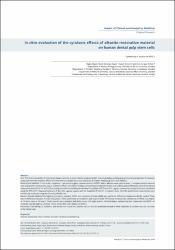| dc.contributor.author | Elgun, Tugba | |
| dc.contributor.author | Capan, Belen Sirinoglu | |
| dc.contributor.author | Duman, Canan | |
| dc.contributor.author | Ordueri, Nazli Ece Gungor | |
| dc.date.accessioned | 2024-02-29T12:10:10Z | |
| dc.date.available | 2024-02-29T12:10:10Z | |
| dc.date.issued | 2023 | en_US |
| dc.identifier.citation | Çapan, B.Ş., Duman, C., Ordueri, N.E., & Elgun, T. (2022). In Vitro Examination of The Cytotoxicity of Alkasite Restorative Material on Dental Pulp Stem Cells. | en_US |
| dc.identifier.uri | https://hdl.handle.net/20.500.12900/320 | |
| dc.description.abstract | Aim: The clinical suitability of restorative dental materials is determined by evaluating their biocompatibility, and physical and chemical properties. The present
study examined the cytotoxic effects of three different dental restorative materials on human dental pulp stem cells (DPSCs).
Material and Methods: In this study, composite, high-viscosity glass ionomer cement (HVGIC), and an alkasite were used. In total, 12 samples of each material
were prepared for cytotoxicity assays. Cytotoxic effects were determined by considering biomaterial releases. Cell viability and proliferation were observed and
analyzed at intervals of 24 and 72 hours using both the methyl-thiazole-diphenyl-tetrazolium (MTT) and xCELLigence cytotoxicity assays. Data were calculated
using the RTCA-DP integrated software of the xCELLigence system and the GraphPad Prism 9.1.1 program. Data from the proliferation experiments were
statistically evaluated using the Two-way ANOVA test.
Results: Alkasite exhibited the highest cytotoxicity, whereas HVGIC and composite did not exhibit any significant difference compared with the control. There
was no difference between the two time points in the cytotoxicity of composite and alkasite in the MTT assay. However, the cytotoxicity of HVGIC was higher
at 72-hours than at 24-hours. Similar results were obtained with both assays. Although alkasite exhibited higher cytotoxicity than composite and HVGIC, all
materials exerted slightly cytotoxic effects (60%–90% cell viability) on DPSCs.
Discussion: Considering its aesthetic, and mechanical properties, alkasite can be clinically preferred instead of other materials in cavities that are not close
to the dental pulp. | en_US |
| dc.language.iso | eng | en_US |
| dc.publisher | Bayrakol Medical Publishing | en_US |
| dc.relation.isversionof | 10.4328/ACAM.21846 | en_US |
| dc.rights | info:eu-repo/semantics/openAccess | en_US |
| dc.subject | Alkasit | en_US |
| dc.subject | Alkasite | en_US |
| dc.subject | Kompozit | en_US |
| dc.subject | Composite | en_US |
| dc.subject | Cam İyonomer Siman | en_US |
| dc.subject | Glass Ionomer Cement | en_US |
| dc.subject | Sitotoksisite | en_US |
| dc.subject | Cytotoxicity | en_US |
| dc.subject | Diş pulpası | en_US |
| dc.title | In vitro evaluation of the cytotoxic effects of alkasite restorative material on human dental pulp stem cells | en_US |
| dc.type | article | en_US |
| dc.department | İstanbul Atlas Üniversitesi, Diş Hekimliği Fakültesi | en_US |
| dc.authorid | Canan Duman / 0000-0003-1240-1285 | en_US |
| dc.contributor.institutionauthor | Duman, Canan | |
| dc.identifier.volume | 14 | en_US |
| dc.identifier.issue | 11 | en_US |
| dc.identifier.startpage | 1 | en_US |
| dc.identifier.endpage | 15 | en_US |
| dc.relation.journal | Annals of Clinical and Analytical Medicine | en_US |
| dc.relation.publicationcategory | Makale - Uluslararası Hakemli Dergi - Kurum Öğretim Elemanı | en_US |

















